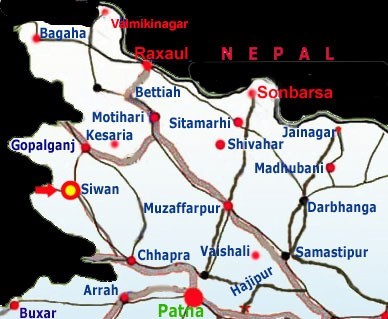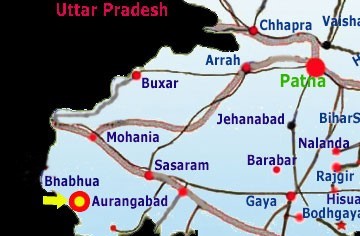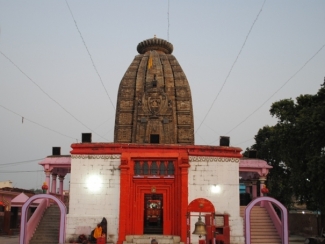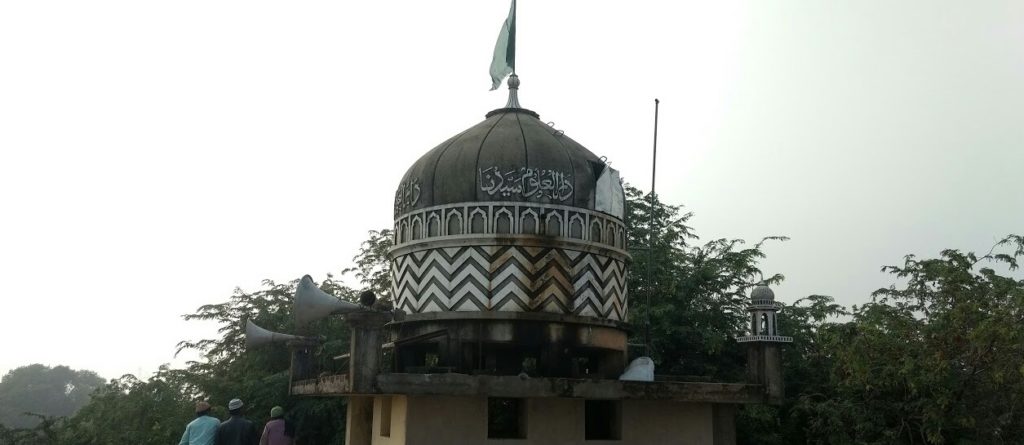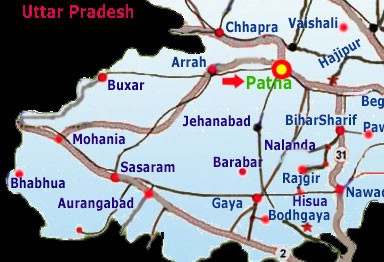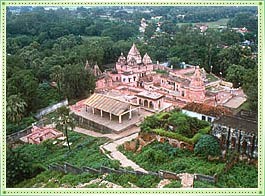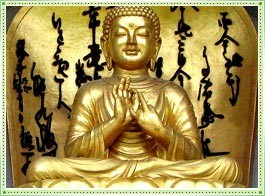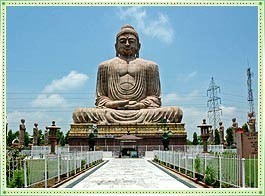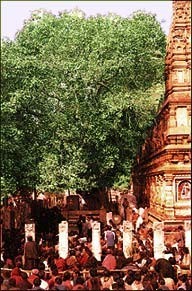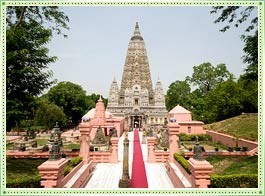Introduction
Patna, which in the ancient times was known as Pataliputra, is the capital of Bihar. The city is among the world’s oldest capital cities with unbroken history of many centuries as imperial metropolis.
The history and heritage of modern-day Patna go back well
over two millennia. The city of Patna is a very fertile stretch of land along
the bank of tbe river Ganga.
Places of Interest
WHAT TO LOOK FOR
Patna Museum
Set up in 1917, the Patna Museum is one of the few grand museums in India, and
is committed to offering a scientific vision to understand the evolution of
history. As a repository of ancient glory, Patna Museum is, however, truly the
cultural pride of Bihar.
This museum has the privilege of preserving the holy relic
casket of Lord Buddha which contains his ashes and other materials discovered
during the excavation of a stupa belonging to sixth century BC at Vaishali.
Among the stone sculptures, a special mention must be made about the famous
female figure of the Mauryan period, third century BC. Discovered at Deedarganj
(Patna), the magnificent statue is popularly known as Deedarganj Yakshi. The
museum also possesses the biggest collection of copper hoards discovered from
various parts of Jharkhand and Bihar.
Museum opens: 10.30 am to 4.30 pm
Closed: On Mondays
Entry Fee: Rs 10
Special fee to see holy Buddhist relic: Rs 100
Phone: 2911190
Golghar
Golghar, an enormous granary, was built by Captain John Garstin for British
army in 1786, after the terrible impact of 1770 famine. The massive structure
is 29 m high and the walls are 3.6 m wide at the base. The winding stairway around
this monument offers a brilliant view of the city and the Ganga flowing by.
Entry is free.
Karpoori
Thakur Museum
Bihar government has declared 1, Deshratna Marg, the official
residence of former state chief minister the late Karpoori Thakur, a memorial
museum to commemorate the life, achievements and philosophy of Late Thakur. The
Jananayak Karpoori Thakur Smriti Sangrahalaya displays and preserves articles
of daily use, clothes, documents, letters, diaries, writings and several other
things that belonged to the former chief minister.
Entry: Free
Monday closed
Phone: 2222537
Martyr’s
Memorial
The Martyrs’ Memorial is a memorial to the seven freedom fighters who
sacrificed their lives during the Quit India Movement in 1942. The memorial is
a modern sculpture facing the Bihar’s State Legislature building where they
were shot while making an attempt to unfurl the national flag.
Jalan
Museum
Jalan Museum at Patna City was built by Late Diwan Bahadur Radha Krishan Jalan
in the year 1954. It is a private museum, and the collection of art objects –
numbering about 10,000 – belongs mostly to the modern period. They include
objects of stone, metal, ivory,glass and porcelains. The museum also contains
impressive private antiques, including a dinner service that once belonged to
George III,Napoleon’s bed, Chinese jade and Mughal silver filigree.
Entry: Prior permission is required.
Patthar-Ki-Masjid
Patthar Ki Masjid is situated on the bank of the Ganga. This beautiful mosque
was built by Parwez Shah, son of Jehangir, when he was the governor of Bihar.
It is also called Saif Khan’s Mosque, Chimmi Ghat Mosque and Sangi
Masjid.
Folk
Art Museum
This museum, set up in the year 1963, has on its shelves folk
musical instruments, costumes and jewellery. It is located at Bharatiya Nritya
Kala Mandir at Chhajjubagh. Its collection also includes terracottas and
ceramic specimens dated between 500 BC and 500 AD.
Entry: Free
Gandhi
Sangrahalaya
The Gandhi Sangrahalaya was set up near the Gandhi Maidan in the year 1967. It
is one of a few institutions established by the authorities of the Gandhi
Smarak Nidhi.The exhibits in the museum include photographs and documents etc
concerning the life and achievements of Mahatma Gandhi. The Sangrahalaya has its
own building on the bank of the Ganga.
Entry: Free
Phone: 2219339,2218260, 9430246317
Email: info@gandhisangrahalaypatna.org
Rajendra Smriti Sangrahalaya
The Rajendra Smriti Sangrahalaya was set up in 1963 in memory of Dr Rajendra
Prasad, the first president of India, with his belongings of daily use and
articles received as gifts and presents. The Sangrahalaya was started in the
same building at Sadaqat Ashram, the Bihar head quarters of Congress party, in
which’ Dr Prasad resided after his retirement from the office of the President
till the end of his mortal life.
Entry: Free
Srikrishna Science Centre
A science museum was established in Patna in the year 1978 which
was named as Srikrishna Science Centre after Bihar’s first chief minister Sri
krishna Sinha. Located at Chhajjubaghon the south western corner of the Gandhi
Maidan,it has been set up with an objective to benefit the public,particularly
students of schoolsand colleges.This institution is a unit of the National
Council of Science Museums, an autonomous body under the Governmentof
India’sministry of culture.
Shaheed Suraj Narain Singh Museum
4, Beer Chand Patel Marg
Entry: Free
Opens: 10.30 am to 4.30 pm
Monday closed
Bihar
Police Museum
This police museum is located on the northern side of the Jawaharlal Nehru Marg
near the Patna Golf Club. It has a collection of old arms and ammunition,
uniforms and other objects handled and used by contemporary police
officials.
Planetarium
Indira Gandhi Science Complex is one of the major attractions in Patna. It is
located on Bailey Road.
Entry: By ticket
College
of Arts & Crafts
This college was set up on January 25, 1939 at Govind Mitra Road, Patna by late
Radha Mohan. India’s first president Rajendra Prasad was the first member of
the management committee of the college. In 1949, the Bihar government took
over the college, and as government’s School of Arts & Crafts, it used to
offer a five-year diploma course. In 1957, the school was transferred to its
newly-constructed building at Vidyapati Marg in Patna. In 1972, it was renamed
College of Arts & Crafts. On April 12, 1977, the college was handed over to
Patna University and its diploma course was converted into a degree course. The
college, located at a distance of nearly one km from Patna railway station, is
an institution for advanced training in visual arts (creative and
applied).
Sanjay
Gandhi Biological Park
Sanjay Gandhi Biological Park is a famous zoo in the state. Of late, it has
also become a favourite spot for joggers and walkers. Children can enjoy toy
train ride, boating and elephant ride. There are a large number of animals and
reptiles in the zoo.
The zoo remains closed on Mondays. One has to pay an entry fee
though entry is free for joggers from 4.30 am to 7.30 am and 4.30 pm to 7
pm.
Clubs
Bankipore Club
Bankipore Club, the oldest in Patna, was founded on the bank of river Ganga at
Patna in 1865. It is one of the oldest premier clubs in the country. It derives
its name from ‘Bankipore’ or ‘Bankipur’ which was the name of the civil station
of Patna district.
The Ganga flows beside it. Coconut and Christmas trees along
with a sprawling lawn over looking the expanse of water flowing by provide a picturesque
beauty to the club. The club provides a vast range of amenities. The old
dancing hall with wooden floor, which is now often used to host wedding
receptions, parties and other functions, was a hotspot in the years of yore.
The weekend cinema show is still a regular event in the club
calendar. There are two lounges and two bars, including an open air bar called
‘Hawa Mahal’. Two canteens and an airconditioned restaurant provide a variety
of dishes. There are separate rummy rooms for smok- ers and non-smokers, the
latter being an airconditioned one. The bridge and billiards rooms too are
airconditioned. With tennis and squash courts along with a swimming pool and
table tennis tables, the Bankipore Club offers a variety of sporting
facilities.
Housie is another weekend favourite event in this club which
also has three well maintained visitors’ rooms for visitors to the city. The
club is affiliated to over a hundred clubs and resorts. Members of outstation
clubs affiliated to Bankipore Club can avail themselves of the Bankipore Club’s
facilities when visiting Patna.
Agreat place for networking, where business mixes merrily with
pleasure. And, you bet, it surely makes a heady cocktail.
Location: In the heart of the city, near Patna District
Magistrate’s office
Entry: Only for members
Patna Golf Club
The beginning of the Patna Golf Club is traced to the lease grant of 165 acres
of land, west of the Government House (now called Raj Bhawan), to the South
Bihar Gymkhana Club by the then government of the province of Bihar and Orissa
in 1916. The club was kept alive by a handful of persons from the city’s upper
echelons of society even after the British left. Several top mercantile houses
chipped in to sustain and develop the club. By April 1968, twenty-five people
formed a small organisation with a membership fee of Rs 10 per month. The group
included Prem Seth, whose son Vikram was to later pen ‘A Suitable Boy’, a best
selling novel about a Patna story.
A boundary was erected to make it an independent adjunct to the
Patna zoo. A club house with approach road also came up, and the golf course
was redesigned to cover 18 holes.
The club is currently spread over 102 acres of greens which,
lying in the midst of the city, also provides a lung to Patna. Now the club has
over 500 members. The club house is very popular among members and their
families who can be seen enjoy the winter sun or chilling out in the spacious
bar in the evenings. The food served at the club house is among the city’s I
best, it is Bihar’s most happening club now. Events: New Year’s Day, Christmas,
special sponsored.
cultural events
Entry: Only for members
location: Bailey Road
Phone: 2287089
New Patna Club
With the establishment of the high court at Patna in 1917, the
English judges and English-educated barristers took the initiative to set up a
new club (patna already had Bankipore Club) where there would be no segregation
and the Indian and the English, virtually all being judges and lawyers of the
Patna High Court, would be able to mingle and socialise without any ethnic
complexes.
On New Year’s Day in 1918, judges E P Chapman and F Roe,
Mazharul Haque, Syed Sultan Ahmed, Syed Hasan Imam, P R Das and Sachchidanand
Sinha met Sir Edward Albert Gait, the then lt Governor of Bihar and Orissa, and
within a fortnight a plot of land extending from the present Beer Chand Patel
Path, then called Gardiner Road, was selected and leased out for the club on an
annual rental of Rs one. But the plot was less than required. Sir Sultan Ahmed
then came forward to help by surrendering a large portion of the land from the
compound of his Sultan Palace adjoining the club land.
This club was named New Patna Club. Duly registered in March
1918, the club was formally established the following year, 1919. It was
essentially an evening club where people activated .the day’s club life with a
game of tennis in the afternoon. This was followed by the arrival after sunset
of members fond of billiards, bridge. A quiet drink in the bar and perhaps
dinner rounded off the evening well spent.
The lush green grass courts of New Patna Club were to even host
a Davis Cup tie between India and Pakistan later. The club house has lounges
and a family room too. The well-stocked bar and the sprawling lawns, tennis
courts and the large swimming pool, which was added later, add to the beautiful
ambience of this club. It has also emerged as a favourite venue to host wedding
receptions in this fast-expanding city where open space is now at a premium.
New Patna Club is affiliated to 63 top clubs across the country.
Events: Regular cultural shows, special programme during
festivals
Location: Beer Chand Patel Path, opposite MIller school
Entry: Only for members
Phone: 2222245
Khuda Bakhsh Oriental Public Library
Khuda Bakhsh Oriental Public library has put the city of Patna prominently on
the global intellectual map. It is a unique repository of the past heritage,
preserved in the form of manuscripts written on paper, palm leaves, deer skin,
cloth and sundry materials. At the same time, it has a modern face, housing
over 2.S lakh books in Arabic, Persian, Urdu, English and Hindi besides a few
in German and French, also in punjabi, Japanese and Russian.
It is administered by a governing board, of which the governor
of Bihar is ex-officio head. The government of India’s ministry of culture
provides funds for the maintenance of this library.
Over the last few decades, the library has grown considerably.
It has now a collection of over 21,000 manuscripts in different languages –
Arabic, Persian, Urdu, pushto, Sanskrit and Hindi. The list of eminent visitors
to the library is unending. The library also has a collection of about 40
Sanskrit manuscripts, written on palm leaves; some are in ‘Mithilakshar’ also.
Three of these are unique in significance, including one which is a
five-century-old collection of ‘Upanishadas’.
It has also a copy of Lord Byron’s ‘Ode to Napoleon’, wherein
two additional stanzas have been added in what is considered to be Byron’s own
handwriting. There is also a diary of Napoleon Bonaparte.
Library opens: 9.30 am to 5 pm
Reading room opens: 8 am to 8 pm
Closed: On national holidays and Fridays
Entry: Free
Phone: 2300209 (Library), 2301507 (Director)
Fax: 2300315
Email: kblibrary.nic.in
Kumhrar
Kumhrar, the site of the ancient city of Pataliputra, lies five km away from
Patna railway station. Archaeological findings in this area establish Patna’s
claim to over a thousand years of political glory – 600 BC to 600 AD. The place
contains the ruins of the ancient city. Very little of this grandeur remains
though, except for the remains of a huge Mauryan Hall supported by 80 sandstone
pillars dating back to 300 BC.
Maner
Manersharif is situated in the extreme northwest of Danapur sub- division,
about 32 km west of Patna on the Patna-Ara highway. Manersharif is the most
important and oldest centres of Sufis in Bihar. Tombs of several Sufi saints,
including the mausoleum of Shah Daulat, a contemporary of Akbar and Jehangir,
are located here.
In the early ages, Maner was a centre of learning and it is said
that grammarian Panini, and also I Bararuchi, lived and studied here.
Bihar State Tourism Development Corporation has a guest house at
Maner.
Begu
Hajjam’s Mosque
Begu Hajjam’s Mosque is located in Patna City (old city) region.
It lies on the roadside to the east of Khajekalan Ghat. This mosque was
originally built by Alauddin Hussain Shah, founder of Hussaini dynasty in
Bengal (1489) and was repaired and renovated in 1646 by a barber named Begu
Hajjam, who gave his name to it.
Phulwari Sharif
Phulwarisharif, seven km from Patna, is another important centre
of the Sufis.The ‘Khanqah Mujeebia’, founded in the 18th century by Pir Mujib,
still commands a large popular following. It has been always a favourite abode
of Sufi saints in various times. Sacred hair of the beard of Hazrat Muhammad
Saheb is preserved here in the ‘Bari Khanqah’ that attracts thousands of his
followers. Abig fair is held here every year.
Meetan Ghat
‘Khanqah Munimia’ at Meetan Ghat in Patna City (old city) is
another 18th century Sufi centre which still attracts many. A beautiful
double-storied mosque was built by Mughal Prince Azim on the bank of the river
Ganga at Meetan Ghat in Patna City that was called Azimabad during the reign of
Mughal emperor Aurangzeb. Every year, after five days of Eid festival, an Urs
Chiraga is held here for which many people assemble at this place.
Mangal Talab
‘Khanqah Emadia’ at Mangal Talab in Patna City is a branch of
the ‘Khanqah Mujeebia’, and has a history of about a century. An Urs is held
here annually when thousands of people assemble and pay their respect to their
beloved Sufi saint. A large number of tourists, including pilgrims from
Pakistan and Bangladesh, visit these Sufi sites.
Mahatma Gandhi Setu
Gandhi
Setu is Asia’s longest road bridge. Situated across the river Ganga, it
connects Patna with Hajipur.
Old
Opium Warehouse
The Old Opium Warehouse is located on the bank of river Ganga at
Gulzarbagh. This opium warehouse was constructed by the East India Company and
is now used as the government printing press. Visitors can enter the three
buildings where opium was packaged before being sent by boat to Kolkata during
pre-independence days.
CHURCHES OF DANAPUR
Churches of Danapur Cantonment have stood as silent spectators
to the happenings’ around for over two centuries. St Lukes Church and St
Stephen’s Church were built in the mid- dle of the 18th century at Danapur
Cantonment, some 10 km from Patna. Britishers raised six regiments at Danapur
during 1756 to 1825 and, as such, the place became a home to a good number of
British officers owing allegiance to the Church of England. Establishment of
churches here, thus, became inevitable.
St Luke’s Church
St Luke’s Church is one of the oldest churches in Bihar. Spread
over an area of one acre, its construction started in April 1827 and it was
completed in 1830. The church, known for its marvellous carvings on the wooden
sheets, was originally a big hall with the sitting capacity for 400 people.
Plaques installed on the walls record the history of the Cantonment. The
British Retreat in Kabul and the First War of Independence in 1857 come alive
on these plaques, dedicated to the memory of Lt A S Bechar who fell victim to
the bullets of mutineers in Lucknowon October 9, 1857.
St Stephen’s Church
St Stephen’s Church is another church in Danapur Cantonment. It
was completed in 1854 under the supervision of Italian priests. The earthquake
of 1934 badly damaged its walls. Its furniture, pews and lectern date back to
1885. A unique feature of this church is its Baptismal font, which is made of
wood. Every artistic piece bears the symbol of the Cross. The brass flower pots
and candelabra here are 137 years old. During the first war of independence in
1857, sisters of St Joseph with children took shel- ter in this church to save
their lives. They stayed in the church till August 1857. However, Mother
Josephine and her sister Mathide Koch died during their confinement.
HOW
TO REACH
Patna is well connected by airways, roadways and railways to
other parts of the country. Air: There are direct flights to and from Kolkata,
Delhi, Mumbai and Ranchi. Railway: All important trains to and from all major
stations of the country have stoppages in Patna. Road: All-weather motorable
roads connect Patna with the rest of Bihar. There are regular inter-state and
intra-state bus services.
By
Air:
Nearest
Airport
Jayaprakash Narayan International Airport, Patna Gaya International Airport,
Gaya (97 kms).
By
Rail:
Nearest railhead
Patna Junction; Danapur Junction; Patna Sahib Junction.
By
Road:
Connected
by good roads with all Indian cities.
Where
to Stay:
Kautilya
Vihar, Beer Chand Patel Path, Patna. Ph: 2225411, 2216219; Fax: 2236218
Hotel Patliputra Ashok, Birchand Patel Path, Ph : 2224207/2505270-76
Hotel Samrat International, Fraser Road, Patna. Ph : 2220560-68, 2221856
Hotel Maurya, Fraser Road, Patna, Ph : 2203040-59
Hotel Chanakya, Birchand Patel Path, Ph : 223141/2223142, 2222167 .
Hotel Mamta, Dak Bunglow Chowk, Patna Ph: 2221311, 2230411
Hotel President, Fraser Road, Patna, Ph : 2209200-05, 2209203-04
Hotel Rajasthan, Fraser Road, Patna, Ph: 2225102-03
Hotel Magadh, Station Road, Patna, Ph: 2321278/9939766231
Hotel Windsor, Exhibition Road, Patna, Ph : 2203250/9204275699
Hotel Sarvodaya, am Nanda, Rajendra Path, Patna, Ph : 2322411-13
Hotel Satkar International, Fraser Road, Patna, Ph : 2220551, 2220556
Nirvana Cottage, B-Block, White House, Budh Marg, Patna,
Ph : 2237117/9835047633/9334023322
BSTDC HOTEL:
Kautilya Vihar, Beer Chand Patel Path, Patna
3 km from Patna airport, 1 km from Patna railway station
Phone: 2225411,2216219; Fax: 2236218
AC/non-AC rooms and dormitory available
Restaurants:
DosaPlaza,Biscomaun:3240755
Boliywood Treat, Maurya Arcade: 2203040 Roti, Boring Road: 9334651612
Mamata Regency(with bar), FraserRoad: 2225888
BuddhaVihar,PatnaJunction: 2204555
NalandaVihar,PatnaJunction: 2206444
Hotel Samrat International: 2220590
MarwariAwas Griha (pure veg): 2220625
Amrapali Restaurant, Beer Chand Patel Marg: 2229272
Madira (with bar), Fraser Road: 2220590
Motels:
Mamata (with bar), Bakhtiarpur, 40 km from Patna
Guest Houses:
There are several government owned and private guest houses
where rooms are available at affordable rates:
CircuitHouse,BeerChand PatelMarg,Patna
NHInspectionBungalow,near Patnaairport
Zoo Guest House, inside Patna zoo
State Guest House (for WIP guests)
Central public sector undertakings including NTPC, NHPC, PGCILhavetheir own
guest houses in Patna
Bihar State Electricity Board Guest House, Patel Nagar
Bihar State Legislature Guest House, Legislature complex
IPS Officers’ Mess, BaileyRoad
SBI Guest House, Bank Road
Patna Youth Hostel, Fraser Road (only for members)
Cultural Centres:
Kalidas Rangalaya, near Gandhi Maidan
Premchand Rangshala, Rajendra Nagar
Bharatiya Nritya Kala Mandir, Chhajjubagh
South Indian Cultural Association (Bharati Mandapam), Vidyapati Marg
Open AirTheatre, Bharatiya Nritya Kala Mandir
S KMemorial Hall, Gandhi Maidan
Anjuman Islamia Hall, Ashok Rajpath
Ravi Bharati Institute, Kurji
IMA Hall, Gandhi Maidan
Vidyapati Bhavan, Opposite Patna Museum
Rabindra Bhavan,Beer Chand PatelMarg
lala lajpat Rai Bhavan, Chhajjubagh
lady Stephenson Hall, near Patna Museum
Emergency, Contact
Bihar Director General of Police: 2217833 (Off), 2268168 (Res),
9431602301 (Mobile)
IG of Police, Patna: 2219406 (Off), 2233323 (Res), 9431822950 (Mobile)
Senior Superintendent of Police, Patna: 2214318, 2219717 (Off), 2320047,
2321467 (Res), 9431822967 (Mobile)
Superintendent of Police (City), Patna: 2219423 (Off), 2219041 (Res),
9431822969 (Mobile)
Medical Emergencies, Contact
Rajeshwar Nursing Home, Kankerbagh: 2367206
Kurji Holy Family Hospital, Digha: 2262540, 2262516
Alok Nursing Home, Khajanchi Road: 2302244, 2302245
Magadh Nursing Home, Rajendra Nagar: 2691515, 2691500, 2690046
Getwell Hospital, Raja Bazar: 2286530, 2289309
Jeevak Heart Hospital, Rajendra Nagar overbridge: 2365814, 2345895
Hai Medical Research Centre, Raja Bazar: 2295533, 2295981
Heart Hospital, Kankerbagh: 2367997, 2356202
Local Transport:
Regular city buses run within the municipal area of Patna You can hire
auto-rickshaw or taxi from the airport, railway station and bus stand, please
bargain hard.
Most popular mode of conveyance in the city is autorickshaw. For any information
and assistance, contact Bihar State Tourism Development Corporation (BSTDC)’
Hotel KautilyaVihar,BeerChand PatelMarg,Patna(Phone: 2225411, 2216219 Fax:
2236218)
Tourist Season:
October to March.
Clothing:
Light cotton in summer and woolen in winter (specially during November
to January).
